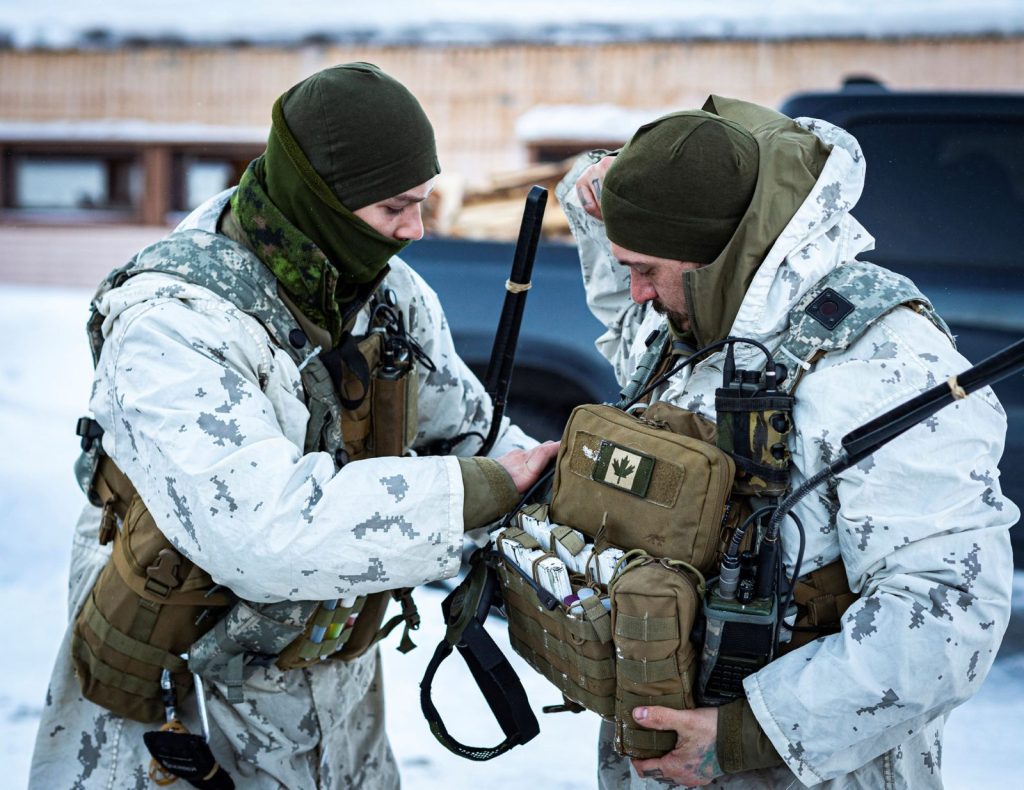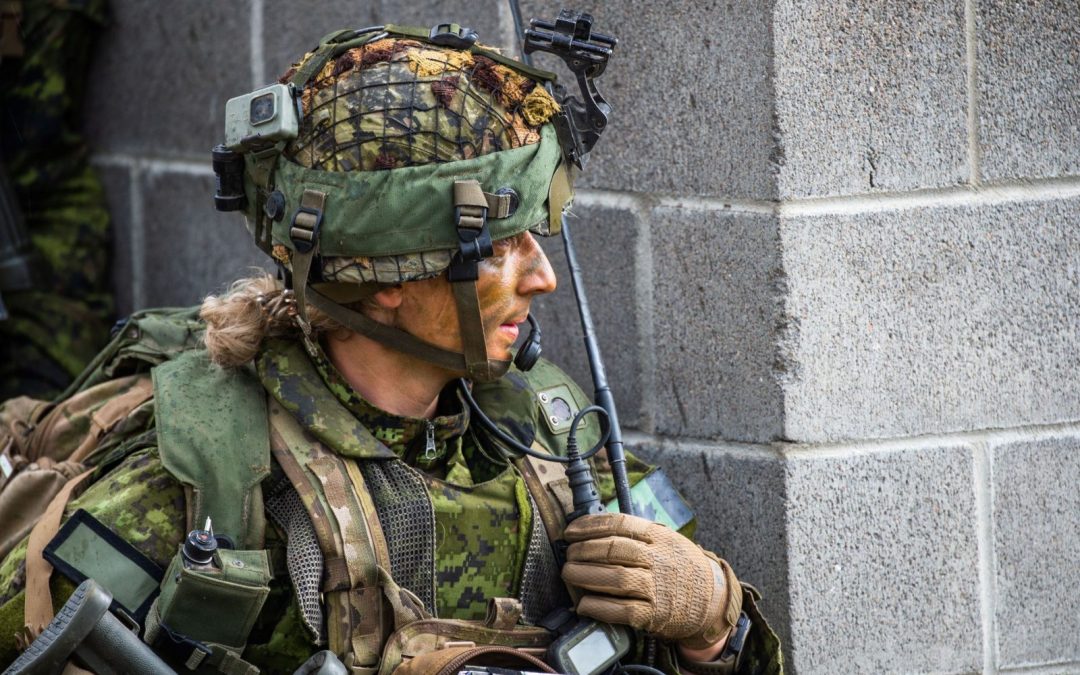by Dave Jones and Bruno Perron
The Canadian Armed Forces (CAF) is either currently engaged with or intends to go to market with an impressive group of large-scale Command, Control, Communications, Computers, Intelligence, Surveillance and Reconnaissance (C4ISR) projects that will deliver the next generation of digitally-enabled warfighting capabilities. It is crucial that these programs are shaped by the doctrinal ambition of Joint All-Domain Command and Control (JADC2) so that the interoperability challenges of systems from the network-centric warfare era are avoided. Unlike our U.S. partners, CAF leadership is rather silent in articulating a coherent strategy, vision, or set of grounding principles that will help collectively the Canadian Army, other CAF services and Canadian defence industry deliver those digitization ambitions.
Many of the elements necessary for success are present throughout the CAF, in doctrine and element specific projects, but unity of effort in the joint environment would maximize the value of generational C4ISR investment programs. Deliberate effort is required to bridge the gap between procurement, doctrinal concepts, and training, which will all need adaptation – with a focus on jointness – while implementing this new generation of systems.
The mirage of interoperability
The Army, Royal Canadian Navy, Royal Canadian Air Force and Canadian Special Forces rely on systems and networks that collectively empower warfighters to deliver capabilities for government objectives. Most of the existing suite of systems are evolutionary from the advent of network-centric warfare pioneered in the 1980s and 1990s, and perhaps best exemplified by the First Gulf War. They have evolved throughout the last decades to underpin joint warfare, enabling high-level commanders with the ability to leverage capabilities from multiple elements or domains. The current Army Land Command Support System (LCSS) is due to be life-cycled and presents the opportunity for increased interoperability, analytics power, and AI-enabled decision support.
But jointness is a bit of a mirage. A former Director of Operations at the U.S. Joint Chiefs of Staff, U.S. Air Force LGen John Dolan, now a vice president at Raytheon Intelligence & Space, has said: “Historically, when we communicate in a large battle, every service [or element in Canada] kind of takes their own approach — an air-centric approach, a ground-centric approach, a navy-centric approach.” Is there an opportunity for the next iteration of LCSS to truly enable integration of joint combat power?
In practice, only specialized Joint Force Commander Headquarters are truly able to benefit from information and intelligence produced by the many Land, Maritime, Air, SOF and Cyber capabilities. Although extremely beneficial to operational and strategic decision makers, lower-level tactical commanders still have difficulty accessing potentially fight-winning or even life-saving information from Joint capabilities. The hard truth is that the CAF, like many NATO partner forces, is underperforming when it comes to conducting Joint operations – and technology is often the reason why.
As U.S. Marine Corps LGen Dennis Crall explains: “This [need] really came to light in some of the crisis actions that we went through for things like Afghanistan, and even what we’re seeing now in the Russia-Ukraine conflict – looking at just simply trying to pull information out of systems that just do not behave right. We can’t live this way any longer.”
Furthermore, a lot of the newly connected data is not exploited or maximized at machine speeds, instead burdening the warfighter’s cognitive workload with frequent menial tasks akin to data entry. The next iteration of LCSS capabilities should aim to push the boundaries on the value of data, empowering decision-makers and possibly enabling a highly automated sensor-to-shooter network. The recently published Army Digital Strategy reinforces that thought.
JADC2 enters the chat
The ambitious Joint All-Domain Command & Control (JADC2) strategy aims to not just tackle the interoperability challenges experienced with network-centric warfare technologies, but it also addresses how the mounds of data, coupled with artificial intelligence will vastly improve decision making at all levels. The U.S Department of Defense explains the concept: “JADC2 provides an approach for developing the warfighting capability to sense, make sense, and act at all levels and phases of war, across all domains, and with partners, to deliver information advantage at the speed of relevance.”
At the center of JADC2 is warfighter decision making, empowered by three main activities:
- “Sense” – Integrate Information Across All Domains and the Electromagnetic Spectrum, which is defined by the ability to discover, collect, correlate, aggregate, process, and exploit data from all domains and sources (friendly, adversary, and neutral) and share the information as the basis for understanding and decision making.
- “Make Sense” – Understand the Operational Environment, with key ambitions to integrate predictive analytics, machine learning and artificial intelligence.
- “Act” – Decide and Disseminate decision to the Joint force and its mission partners. The JADC2 strategy makes specific mention of using a Mission Command approach empowering subordinate commanders with the confidence, authority, and Joint resources to accomplish a senior commander’s operational intent.
The U.S. military is already experiencing procurement obstacles to meet the challenge of JADC2. Northrop Grumman’s chief technology officer Scott Sapp has said that “the services — which by law are responsible for budgeting and managing acquisition of weapon systems — remain focused on fixing service-specific problems in connecting their individual platforms, sensors and C2 networks, rather than thinking across the width of the military.”
Instead of individual services, the CAF is separated into comparable elements, which like in the U.S. play a significant role in procurement. This creates artificial obstacles for programs intended to address technological challenges to Joint operations.

Photo: MS Dan Bard
Mind the gap
Over the next years, the Department of National Defence intends to deliver numerous massive C4ISR projects worth multiple billions of Canadian dollars. These are spread throughout the Force, with each service leading a portion. This is not the complete list of C4ISR projects, but a short list of the key upcoming capabilities that would be a good fit within a JADC2 construct to articulate the complexity of this procurement challenge:
Royal Canadian Air Force
- NORAD Modernization;
- Platform specific C4ISR capabilities (RPAS project, CF18 replacement program); and
- Tactical Integrated Command, Control and Communications Air (TIC3Air).
Royal Canadian Navy
- Platform specific C4ISR capabilities (CSC, AOPS, JSS);
- Intelligence, Surveillance, Target Acquisition, and Reconnaissance (ISTAR) unmanned aircraft system (UAS).
Canadian Army
- Intelligence Surveillance Reconnaissance Modernization (ISR Mod);
- Land Command Support System – Tactical Command and Control Information System Modernization (LCSS – TC2ISM); and
- Joint Deployable Headquarters and Signals Regiment Modernization (JDHQSRM).
Information Management Group
- Information Technology Infrastructure in Support of Command and Control (ITI in Sp of C2).
Canadian Forces Intelligence Command
- Network enhancement projects.
In addition to this list of digitization projects, there are many other smaller scale sensor-to-shooter enhancement projects across the CAF. It is appreciated that the CAF is looking to address shortfalls and aim towards achieving technological superiority. Invariably, the short list above is a set of extremely complex and sophisticated capabilities, which leads us to ask a few questions: Does the CAF want to interconnect these capabilities for a Joint force commander, and extend to subordinate Army commanders? What is the glue between all these DND/CAF C4ISR projects? These complex projects will get awarded to different prime contractors: Who is the CAF chief architect that sets the cadence in terms of the network solution to implement?
Increasingly in vogue is this term glueware to denote crucial gaps between various individual defence requirements.
To avoid the underperformance of Canada’s network-centric warfare capabilities, DND’s procurement community needs to articulate requirements that position its C4ISR projects for successful implementation of JADC2. But the first step is that the CAF leadership needs to set a strategy so that both the troops and defence industry all have a shared and common understanding, if there is the ambition to build this joint all-domain warfighting enterprise.
Because this JADC2 architecture is such a leap forward, CAF leadership must also understand that they must increase their trust and reliance on defence industry technology leaders who understand and can deliver on the ambition, and who devote significant efforts to fully understanding the detailed user-experience required to deliver on this conceptual promise. The Army Digitization Strategy combined with the list of projects above is evidence they are thinking in the right direction and in absence of a true joint strategy that includes industry’s role, they will likely be the service that pulls the next iteration of joint interoperability.
LCol (Ret’d) Dave Jones is VP Business Development at CINTIQS. He served 29 years as an Air Force Communications and Electrical Engineer and Special Forces operator, spending most of his time in Joint and Special Forces communities. His last Regular Force appointment was leading CANSOF’s C4ISR capability development portfolio. Maj (Ret’d) Bruno Perron is a Solutions Architect at CINTIQS. He served 12 years as a Canadian Army intelligence officer providing human terrain advice to technologically focused commanders within Canada’s Signals Intelligence, Electronic Warfare and Cyber communities. He also served as a foreign exchange officer at U.S. Cyber Command.

